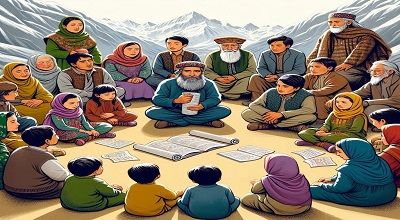History of Gilgit-Baltistan
History of Gilgit-Baltistan: Gilgit-Baltistan, formerly known as the Northern Areas, is a region in northern Pakistan. It is known for its stunning mountainous landscapes, including K2, the second-highest peak in the world. The history of Gilgit-Baltistan is rich and complex, reflecting its strategic location and diverse cultural influences.
Ancient History
The early history of Gilgit-Baltistan is marked by its strategic importance as a crossroads of various civilizations. Around the 3rd century CE, the region was influenced by the Kushan Empire, followed by periods of control by the Chinese and Tibetan empires. The Dards, an ancient ethnic group, are among the earliest known inhabitants mentioned in classical Greek and Roman texts.
The Tibetan and Chinese Influence (600-900 CE)
During the mid-600s, Gilgit came under Chinese suzerainty after the fall of the Western Turkic Khaganate. The Tibetan Empire wrestled control from the Chinese in the late 600s but faced challenges from the rising Umayyad and Abbasid Caliphates. The region saw fluctuating control between Chinese and Tibetan forces until the mid-700s. Buddhism became firmly established during this period, with significant cultural and religious exchanges occurring with Ladakh and India (Wikipedia) (Wikipedia).
The Trakhan Dynasty
Following the decline of Tibetan control, the Trakhan Dynasty emerged, ruling over Gilgit-Baltistan for nearly a millennium. Local traditions and historical accounts suggest that the Trakhan rulers succeeded the Patola Shahis and maintained control until the 19th century. This dynasty was crucial in shaping the region’s cultural and political landscape (Wikipedia).
The Dogra Rule and British Influence (1840-1947)
In the mid-19th century, Gilgit-Baltistan became part of the princely state of Jammu and Kashmir under the Dogra Dynasty. The British, concerned about Russian expansion, established the Gilgit Agency in 1889, bringing the region under their direct control through a lease agreement in 1935. This period saw the establishment of the Gilgit Scouts, a local paramilitary force trained and led by the British (Wikipedia) (Zameen Properties).
Independence and Accession to Pakistan (1947-1948)
With the partition of British India in 1947, Gilgit-Baltistan became a flashpoint. The local Gilgit Scouts, led by Col. Mirza Hasan Khan, revolted against the Maharaja of Kashmir and declared the Islamic Republic of Gilgit on November 1, 1947. After a brief period of independence, the region acceded to Pakistan on November 16, 1947. The Pakistani government appointed a Political Agent to administer the region, implementing the Frontier Crimes Regulation (FCR) (Zameen Properties).
Modern Administrative Changes (1970-Present)
In 1970, the region was renamed the Northern Areas and included the former Gilgit Agency, Baltistan, and several princely states. In 2009, it was granted limited autonomy and renamed Gilgit-Baltistan under the Gilgit-Baltistan Empowerment and Self-Governance Order. Despite calls for full provincial status, the region remains an administrative territory of Pakistan due to the ongoing Kashmir dispute (Wikipedia) (Wikipedia).
List of Trakhan Rulers
The Trakhan rulers of Gilgit-Baltistan played a pivotal role in the region’s history. Here is a list of notable rulers:
- Navasurendrāditya-Nandin (644-655 CE): A ruler of the Palola Sāhi dynasty, known for numerous Sanskrit inscriptions.
- Jayamaṅgalavikramāditya-Nandin (late 600s-early 700s CE): Another prominent ruler of the same dynasty.
- Su-fu-she-li-ji-li-ni (717-719 CE): A ruler of Great Palola who sent delegations to the Chinese imperial court.
- Mo-ching-mang (721-722 CE): The king of Little Palola sought Chinese military assistance against Tibetan forces.
These rulers reflect the deep historical ties between Gilgit-Baltistan and major regional powers. Such as China and Tibet during their respective reigns.
Conclusion
The history of Gilgit-Baltistan is a tapestry of various cultural, political, and religious influences. Shaped by its strategic location and rich heritage. From ancient times under the Kushan and Tibetan empires to its modern status as a Pakistani administrative territory. Gilgit-Baltistan continues to be a region of immense historical significance and cultural diversity.
